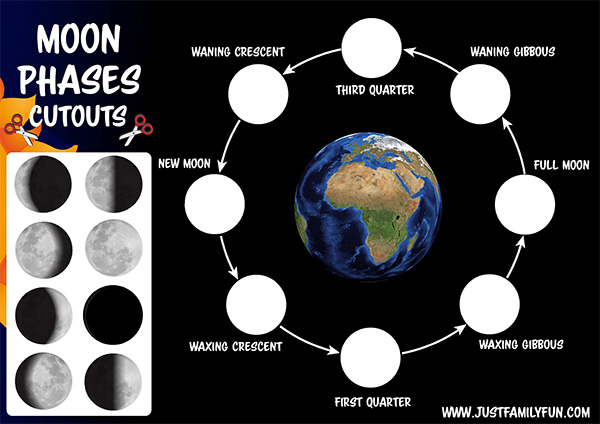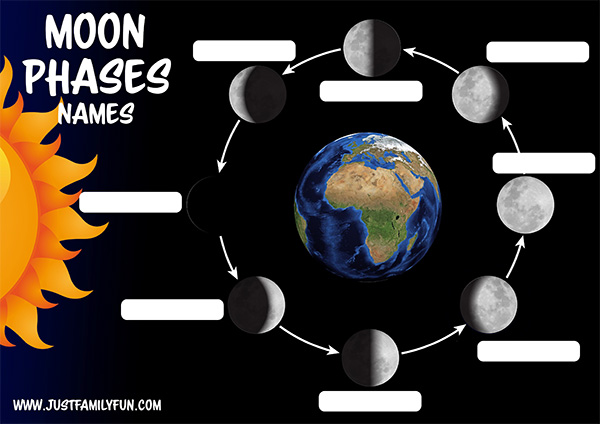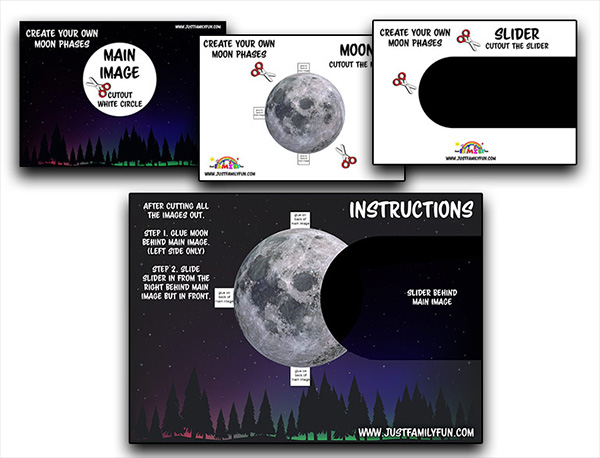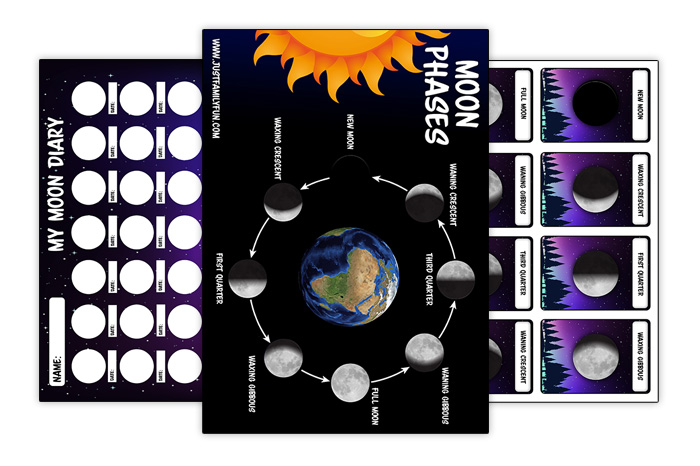The Phases Of The Moon For Kids
Table of Contents
For lovers of space and all things science, we’ve got the perfect printouts and activities for all the phases of the moon for kids.
Space activities are a great way to inspire learning and create fun, engaging educational activities for children. Like our other printable educational resources, our moon phases worksheets and activities are entirely free to download and cut out, or to use digitally for e-learning and fun online activities for kids.
In addition to informative, educational posters and worksheets on the lunar cycle, we also have free activity sheets to boost interactive learning, such as word searches for kids. You’ll be an expert on the moon in no time!
What’s included In the phases of the moon for kids pdf
The cycle of the moon is a fascinating topic for activities and lessons alike, whether you’re a teacher, a parent, or just someone looking for fun moon activities for kids. Here, you’ll find an array of free educational posters and activities that can be downloaded as a high-quality PDF. They’re not only great for digital learning, but are also printable for decorations, games, lesson plans, slideshows, and more.
Starting simple, we have the eight phases of the moon on a printable poster, showcasing what each moon cycle stage is called and what they look like. This exciting space-themed poster also indicates where the moon is in relation to the Earth and sun during each of its stages. For example, a full moon occurs when the moon is furthest from the sun on the opposite side of the Earth! This free printable moon chart is great for visual learning about space and the cycle of the moon, though it also makes perfect decor for a classroom or space-themed bedroom.
To test your kids’ knowledge of the moon, we’ve also got a copy of the moon phase poster with blank moon templates and cutouts. Once your kids have learned all about the moon phases, you can double-check their knowledge using our free moon phase cutouts! Simply cut out each moon phase, and task them with sticking each one in the right place around the Earth. Interactive learning is a great way to aid their memory skills and image recognition, all while boosting their cognitive thinking and fine motor skills, if allowed to cut and glue.
If you’re looking for a no-mess educational activity, we’ve got a similar poster to our blank moon templates with empty text boxes instead. Rather than cutting and glueing, use the empty spaces to write the name of each moon phase next to the correct moon image. Not only will this test your kids’ knowledge of moon cycles, but it’ll help with spelling and handwriting. From the waxing gibbous to the new moon, let’s see how many they can name by themselves!
In addition to educational posters and resources, we’ve got an interactive moon diary for kids that’s perfect for keeping learning engaging and fun. With a blank moon diary template, your child can track the moon in real life by shading in each moon phase and keeping track of the date. While moon diaries are perfect for interactive teaching, they’re also a great home activity for kids who love science and astronomy. We’ve also got printable moon phase flashcards showing what each moon stage looks like and what they’re called, featuring a colourful starry night-time background.
These are great for memory games, as well as testing how well kids know the order of the moon’s stages. Similarly, why not have a go at our DIY create-your-own moon phases worksheet? Featuring a large, realistic picture of the moon, this worksheet can be used to cover and uncover the moon, showing off its various life cycles in real time. It’s a great tool for learning, as well as a fun, no-mess interactive activity that can be done at home or in the classroom. Alternatively, check out our wordsearch and moon maze for a fun interactive learning game!rft
Moon Phases Printable Poster
The fun begins with our 8 phases of the Moon printable poster. Perfect for displaying on bedroom walls, and handy for checking the answers when learning about Moon phases in the rest of the pack.
Why Are There Phases of the Moon?
- The Moon does not produce its own light but is lit up by the Sun.
- As the Moon orbits Earth the parts of the Moon that are reached by the light from the Sun change.
- When the Moon and Sun are on opposite sides of the Earth we have a full moon, as we can see the side of the Moon that is fully lit by the Sun.
- When the Moon is between Earth and the Sun the side of the Moon that is in shadow is facing us and we can’t see it. This is called a new moon.

Use our printable phases of the Moon chart to ask your child questions like;
‘Does the amount of the Moon that is lit up by the Sun increase or decrease after the new moon?’ This will help them to notice the order of the Moon phases, indicated by the arrows.
Moon Fact – WAXING means getting bigger and WANING means getting smaller. Can your child see that the lit part of the Moon is getting larger at the waxing crescent and gibbous and smaller at the waning crescent and gibbous?
Moon Phases Cutouts
Time to get interactive. Your child can cut out our printable pictures of the phases of the Moon and stick them onto the sheet in order. This activity will support your child in being able to recall the phases. They can check their answers on the Moon Phases Printable Poster (page 1).
Moon Fact – The word GIBBOUS comes from the word humpback. It describes a curved shape larger than a semi-circle but smaller than a circle.As can be seen in the waxing and waning gibbous moon phases.

Moon Phases
Let’s start naming. Now that your child has seen how the shape of the Moon changes, it’s time to learn the names of the Moon phases. This is an ideal look, cover, write, check activity. Your child can use Moon Phases Printable Poster (page 1) to look at the names and spellings before giving it a go themselves.
Moon Fact – The surface of the Moon can be extremely hot and also incredibly cold. When the Sun is lighting it up, temperatures can reach higher than boiling, 127oC. When the Moon is in shadow, temperatures drop to a very frosty -153oC.

My Moon Diary
A fantastic way to cement learning Moon phases is to experience it in real life. Your child now has the chance to use our Moon phase tracker to observe the changes for themselves.
Simply look for the Moon each night and shade the circles to show the amount of Moon lit up. Can they name the phases they have observed?
Moon Fact – It takes 27.3 days for the Moon to orbit the Earth.

Moon Phases Flashcards Printable
Use our beautiful phases of the Moon printable cards to aid recall of the phases of the Moon.
Hold up the flashcards, taking care to cover the name, and ask your child which Moon phase is being shown. Correct answers go in a pile on the right and incorrect in a pile on the left. As you repeat the game more cards should end up on the right, fantastic!
Moon Fact – The Moon has earthquakes too. They are called MOONQUAKES! They are not as strong as our earthquakes but they can last up to 30mins.

Create Your Own Moon Phases
Here we have another fantastic opportunity for interactive learning.
- Cut the white ‘main image circle’ out of page 6.
- Cut the Moon out of page 7 – take care to keep the tabs attached.
- Glue the Moon to the back of page 6 by gluing the tabs. Now your Moon should be shining in the sky through the hole you made on page 6.
- Cut out the slider on page 8.
- Slide the slider in front of your Moon.
- Congratulations! Your child can now create their own Moon phases. Give them examples e.g. crescent and gibbous and ask them to demonstrate them for you.

Moon Wordsearch
Here your child can practice their new Moon vocabulary and pick up some new words too. They will have fun seeking them out in this beautiful wordsearch.
Moon Fact – The surface of the Moon is covered with craters caused by impacts from comets and asteroids. As the Moon does not have weather, like us, the craters haven’t been worn away. This is why we can see them clearly so many years later.

Find the Way to the Moon
For one last challenge, see if your child can follow the paths and guide their rocket to the moon! All they’ll need to do is test the different flight paths and find a clear way to land on the moon, making this the perfect no-mess activity to keep kids engaged. How about making it even more of a challenge and timing who can complete the maze quickest?
Moon Fact – The first person to walk on the Moon was Neil Armstrong in 1969, but most people know that. However, did you know that a total of 12 people have walked on the Moon? The last person to walk on the Moon was Commander Eugene Cernan on the Apollo 17 mission in 1972.

Download More Space Printables
If you’re still thirsting for space-themed activities, worksheets, decorations, or anything else, we’ve certainly got you covered. Among our many free activities and free educational resources, we’ve got plenty of space downloadables that can all be printed or used digitally. If you’re looking for more space games and activities, check out our downloadable Earth and space activity sheets, or try our printable space and planet flashcards to create your own games, like matching and memory games.

